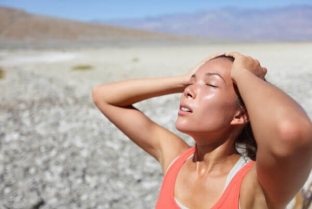Summer will come soon, and with it: heat, closeness, scorching sun and its negative impact on the human body. Being indoors, in a car or outdoors in direct sunlight and even in the shade can cause heat stroke. Many people confuse the symptoms and consequences after heat stroke and sunstroke. In fact, these manifestations are very similar to each other. Heatstroke can happen to anyone around you. Therefore, it is important to have full knowledge of how first aid is provided for heat stroke. Consider on estet-portal.com the main measures to help with overheating of the body.
What is heatstroke and how is it different from solar
Heat stroke is the result of overheating of the body under the influence of stuffiness and high air temperature, expressed by a violation of thermoregulation, deterioration in general well-being, water-salt imbalance. This is a general concept, a variation of which is the term "sunstroke".
Sunstroke – This is an overheating of the body and a violation of blood circulation under the influence of sunlight. Often, sunstroke occurs against a background of heat. The brain suffers the most from sunstroke. This is due to the expansion of blood vessels under the influence of direct sunlight.
Both heat and solar, hitting doesn't just happen when it's hot on the beach. A person can feel unwell, flies in the eyes and dizziness in a traffic jam, in public transport, on a train, in the shade in a country house, while working in a workshop at a factory, in a bathhouse and a sauna.
Read also: How not to get burned while sunbathing
Symptoms of heat stroke: how to recognize an emergency
- shortness of breath, severe headache;
- fatigue and drowsiness;
- blackout, dizziness;
- vomit;
- problems with pulse (weak and fast);
- trembling, sweat;
- pupil dilation;
- redness of the skin on the face;
- fainting;
- nausea;
- nosebleed (can also be a sign of sunstroke);
- convulsions;
- cyanosis of the skin;
- increase in body temperature.
Worst of all, overheating of the body is tolerated by the elderly, pregnant women and children. In case of heat stroke in children, you should be especially attentive to the child and immediately provide assistance.
Timely first aid for heat stroke can save the life of a person who is nearby. Therefore, it is so important to understand what measures to take at the first symptoms of overheating.

First Aid for Heat Stroke
If a person has a heatstroke, he is unconscious and there is a clear threat to life, you should immediately call an ambulance. If the signs of heat stroke are quickly identified and treated, the consequences can be managed without medical intervention.
First aid flow chart for a heatstroke victim:
- Remove the negative impact on the patient: shift or help move to a shade, ventilated building with air conditioning or a fan to provide cool air flow and protect from the sun.
- Remove all necessary clothing, free the neck, arms and legs, place the patient as comfortably as possible on the plane, placing a cushion under the head (a pillow or something else from improvised means). If a person is unconscious, the victim should be protected from swallowing vomit and tongue and shifted to the stomach, placing his head on one side. Such activities are done in the presence of a pulse and heartbeat.
- Apply a cool towel or pieces of ice to your forehead, arms and neck. You can also completely undress the victim and cover with a sheet soaked in cool water.
- Ensure airflow with a fan by opening windows and doors.
- If the patient is conscious, give water at room temperature, juice, or make a solution of water and salt (1 tsp of salt per 1 liter of water) to drink to restore the water-salt balance.
- When fainting, give a sniff of ammonia so that the person comes to his senses.
Medical First Aid for Heat Stroke:
- Injection of glucose-salt solutions.
- Administration of injections to resume cardiac activity.
- Administration of anticonvulsants and antipyretics.
- Providing oxygen inhalation.
- Artificial ventilation.
After heatstroke, you should stay in bed for a few days to avoid recurrence.
Read also: Heat Stroke: Causes, Symptoms and First Aid
How to avoid heatstroke: Precautions
First aid for heatstroke may not be necessary if you follow the simple rules of sun exposure:
- Do not stay in direct sunlight from 12.00 to 16.00.
- If you need to get outside during hot lunch hours, don't forget a hat, umbrella and sunscreen.
- Give preference to clothing made from natural fabrics.
- Drink plenty of fluids, carry a container of at least 1 liter of water with you.
- Ventilate the room where you work, sleep, and relax.
- Don't drink alcohol during hot weather.
- Avoid stomach overload.
Watch your well-being and the reaction of the people around you in the sun. Dehydration and overheating of the body can significantly harm your well-being and unsettle for at least a week. Stay fit and drink more fluids in the summer!






Add a comment